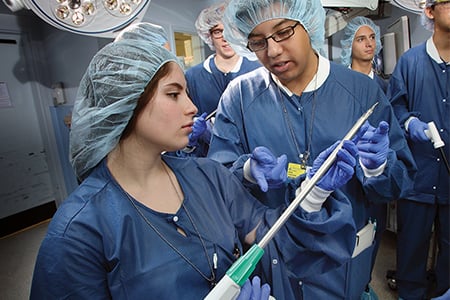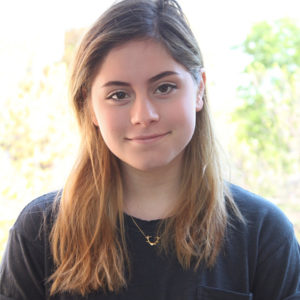Brooke Stephanian was diagnosed with type 1 diabetes while in high school. The experience propelled her to pursue studies in biomedical engineering.
“Learning to use an array of medical devices to manage my health showed me firsthand how unintuitive and frustrating many of these tools were to use,” she says. “By studying biomedical engineering, I aim to find ways to improve the medical technologies people use daily to manage their conditions.”
Since sophomore year, the senior from Terre Haute, Indiana, has worked in the Photoacoustic & Ultrasonic Systems Engineering (PULSE) Lab directed by Muyinatu Bell, where she has worked on simulating photoacoustic images to improve image quality. The research conducted there dovetailed nicely with an internship she landed the summer after her junior year, working in the neurosurgical division of Medtronic. There, she developed workflow improvements to the O-arm, an intraoperative X-ray imaging system, working with neurosurgeons to understand clinical needs in spine procedures and develop tests to evaluate them.
“Seeing how research provided the foundation for the design of medical devices helped me realize my aspirations to impact patients with new innovations in healthcare,” she says, “and it emphasized the importance of cross-functional collaborations between physicians and engineers to create the most effective tools for assisting in medical procedures.”

Stephanian has made her academic focus biomedical imaging and instrumentation, which she says gave her the flexibility to explore a breadth of courses in areas ranging from tissue engineering to microfabrication to biomaterials, while also taking classes relevant to her research in the PULSE lab. The coursework combined different aspects of engineering, providing her a holistic view of biomedical research and its applications.
“The most interesting aspect of BME is the range of career opportunities that the program provides, and the opportunities to work on real-life problems through the Design Team program,” says Stephanian. She was involved in the program as a freshman and again as a senior leading her own team that developed and commercialized a surgical device to simplify facial reconstructive procedures and improve patient outcomes. “The program is focused not only on developing technical and team management skills but also on ensuring that students have a strong understanding of the clinical problem so they can be confident that their solution will provide value to physicians and patients.”

When she’s not in the lab, Stephanian pursues her creative talents, playing the flute or metalsmithing to create jewelry. She also started a group on campus that built the Johns Hopkins entrepreneurial ecosystem and The Hatchery, the Johns Hopkins undergraduate incubator. “Building an incubator from the ground up introduced me to how rewarding entrepreneurship can be for students,” she says.
She also enjoys going to the Baltimore Museum of Art or the Hampden neighborhood on weekends for great art and food, and taking advantage of the regional MARC trains to Washington, D.C.
Stephanian says she recommends that incoming BME students follow the path that most interests them: “The classes we take as BMEs can be extremely difficult, but there is no shortage of fascinating classes. Whether you’re curious about computational biology or neuroengineering, you can find what you’re passionate about in the BME department.”
In addition, she says she feels “incredibly lucky” to have access to some of the world’s premier biomedical researchers. “Many faculty members are not only working on interesting and high-impact research in their respective fields, but are also passionate about translating their work to impact health outcomes. The faculty are also incredibly supportive of student-led projects.”
After graduation, Stephanian plans to work for NASA and complete a master’s degree program before going to medical school. Through the BME program, she says, “I have attained an understanding of biological systems and the role physicians play in bringing new technologies into patient care. The Design Team program especially focuses on taking an idea from benchtop to bedside, and I am extremely fortunate to have been taught in the technical and clinical foundations necessary to design and develop new medical technologies. The program also emphasizes the importance of foundational computer and data science skills, which are becoming more relevant in many fields including BME.”
